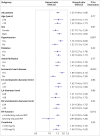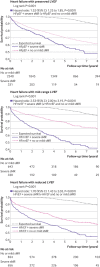Burden, treatment use, and outcome of secondary mitral regurgitation across the spectrum of heart failure: observational cohort study
- PMID: 34193442
- PMCID: PMC8243241
- DOI: 10.1136/bmj.n1421
Burden, treatment use, and outcome of secondary mitral regurgitation across the spectrum of heart failure: observational cohort study
Abstract
Objectives: To define prevalence, long term outcome, and treatment standards of secondary mitral regurgitation (sMR) across the heart failure spectrum.
Design: Large scale cohort study.
Setting: Observational cohort study with data from the Viennese community healthcare provider network between 2010 and 2020, Austria.
Participants: 13 223 patients with sMR across all heart failure subtypes.
Main outcome measures: Association between sMR and mortality in patients assigned by guideline diagnostic criteria to one of three heart failure subtypes: reduced, mid-range, and preserved ejection fraction, was assessed.
Results: Severe sMR was diagnosed in 1317 patients (10%), correlated with increasing age (P<0.001), occurred across the entire spectrum of heart failure, and was most common in 656 (25%) of 2619 patients with reduced ejection fraction. Mortality of patients with severe sMR was higher than expected for people of the same age and sex in the same community (hazard ratio 7.53; 95% confidence interval 6.83 to 8.30, P<0.001). In comparison with patients with heart failure and no/mild sMR, mortality increased stepwise with a hazard ratio of 1.29 (95% confidence interval 1.20 to 1.38, P<0.001) for moderate and 1.82 (1.64 to 2.02, P<0.001) for severe sMR. The association between severe sMR and excess mortality was consistent after multivariate adjustment and across all heart failure subgroups (mid-range ejection fraction: hazard ratio 2.53 (95% confidence interval 2.00 to 3.19, P<0.001), reduced ejection fraction: 1.70 (1.43 to 2.03, P<0.001), and preserved ejection fraction: 1.52 (1.25 to 1.85, P<0.001)). Despite available state-of-the-art healthcare, high volume heart failure, and valve disease programmes, severe sMR was rarely treated by surgical valve repair (7%) or replacement (5%); low risk transcatheter repair (4%) was similarly seldom used.
Conclusion: Secondary mitral regurgitation is common overall, increasing with age and associated with excess mortality. The association with adverse outcome is significant across the entire heart failure spectrum but most pronounced in those with mid-range and reduced ejection fractions. Despite these poor outcomes, surgical valve repair or replacement are rarely performed; similarly, low risk transcatheter repair, specifically in the heart failure subsets with the highest expected benefit from treatment, is seldom used. The current data suggest an increasing demand for treatment, particularly in view of an expected increase in heart failure in an ageing population.
© Author(s) (or their employer(s)) 2019. Re-use permitted under CC BY-NC. No commercial re-use. See rights and permissions. Published by BMJ.
Conflict of interest statement
Competing interests: All authors have completed the ICMJE uniform disclosure form at www.icmje.org/coi_disclosure.pdf and declare: this work was supported by the Austrian Science Fund (FWF). MA received proctor fees from Edwards Lifesciences and Abbott and adviser fees from Medtronic. JM received speaker fees from Edwards Lifesciences, Boston Scientific, Medtronic, and Abbott. CH received proctor fees, speakers bureau, and institutional grant from Edwards Lifesciences and Boston Scientific. The remaining authors have no other relationships or activities that could appear to have influenced the submitted work.
Figures




References
Publication types
MeSH terms
Grants and funding
LinkOut - more resources
Full Text Sources
Medical
